A Solar Panel to be an investment
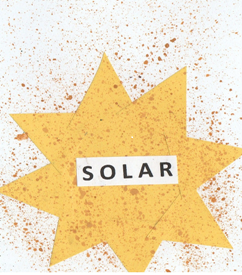
Solar panels are modular. The panels are flexible, easy to use, and affordable.
What I love about solar panels is that you can flex them, fold them or carry them. You can also attach it to a building, caravan, shed, or any other surface of convenience.
I love solar panels because:
Well, I had this idea of the very negative impact mankind has on our planet, and that our governments must fix it.
Also, I have been so unhappy with the ever-increasing price of electricity. It made me feel so angry, hopeless, and dependent. Dependent on authorities that do not care.
I had so many questions in my head. One that was strong in my mind is whether a move to solar could still be a smart investment.
I realized that I cannot wait for the government. I must make a difference myself. It will only be a drop in the ocean, but I can do it. If more and more people can do it, the change can be significant.
I can become independent, and solar can be a wonderful investment. Expensive, but due to its modularity I do not have to do it all at once. It will still be cheaper than an ever-increasing electricity bill.
I also love the possibility of a low carbon future and the fact that users of solar panels can contribute to this future.
I made up my mind
I made up my mind about solar panels. Solar is the way to go.
Now I went through a time of reading, questions, and what-ifs.
Solar module sizes, charge controllers, batteries and inverters. Also DC (direct current), AC (alternating current), volts, current and power in watts.
In the end, everything made sense. I understood where every component fit in. I could go ahead. I could make my solar move.
Many years ago, I got a master's diploma in technology. That helped me so much. It is not a necessity, but the technical detail made much more sense.
So, what are solar panels?
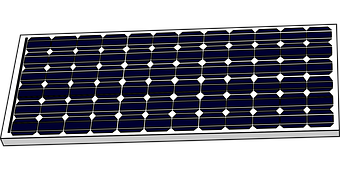
A solar module uses sunlight as a source of energy to generate electricity or heat.
Panels are flat and manufactured in various sizes. That is why it is possible to use it in many applications.
Photovoltaic; (Referred to as light, making voltage)
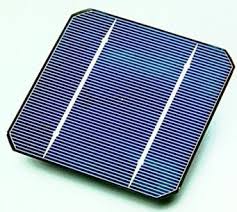
A photovoltaic panel generates electricity. It is a collection of cells that form a panel. Each cell generates a small amount of electricity.
You add the outputs of these low voltage cells together. The panel then generates an acceptable amount of electricity.
The output from a solar module supplies electricity to external devices.
One can configure the panels to have different DC voltage outputs. We do this when connecting the cells in a variety of parallel and/or series combinations.
Solar panels are then also called photovoltaic panels (or PV panels). It is also referred to as solar modules or photovoltaic modules or even as PV modules.
Most of the PV modules are for small-scale residential electricity requirements.
You get three types of solar panels
Each of these has different pros and cons and is suitable for specific applications.
Operation of a photovoltaic panel
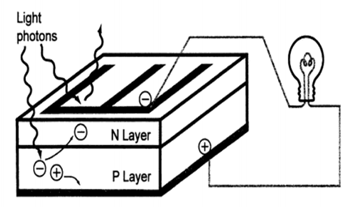
The cell of a solar module contains flat layers of a semiconductor such as silicon.
At the present silicon is most used in the manufacturing of solar panels.
They dope the silicon with other materials to give each layer a positive or a negative charge.
An electric field, thus, exists at the junction between the silicon layers or “slices”.
When a photon of sunlight shines on the solar cell an electron breaks free. The electric field then pushes the electron out of the junction.
There are metal conductive plates placed on the sides of the cells. These plates collect the electrons. The electrons move to wires connected to the cells. Electric current flows to then generate electricity.
The collections of cells in a solar module generate an amount of electric energy. We measure it in watts.
Arrays
With the panels exposed to the sun, it generates electricity. To generate the required amount of electricity you connect many solar panels together.
You can connect the group of panels in series or in parallel or it can be a series-parallel combination. It all depends on the size, output, and your requirements.
Such an assembly of solar modules forms an array.
Economics and efficiency
The efficiency of solar panels can be around 15 to 17%. New technology can produce solar panels with an efficiency of up to 22%.
Higher efficiency brings a reduction in cost and big savings of space. The ideal is to make lower capital investment and to use less space, but get higher usable wattage.
In the future, technology will improve, and prices will reduce. Also, efficiency will improve. This is due to high demand, improved development, and better manufacturing. Also, many players that compete for a strong market position.
Is it true that a solar panel saves energy?
Some people reckon that a solar module does save energy. This is not true.
With solar, we use another source of energy which is free and nonpolluting. We still use energy though, and with solar we do not always reduce our power consumption.
The advantages associated with a solar panel.

When using solar you can reduce your carbon footprint. You save money and become more independent.
You can improve the value of your property, reduce costs, and enjoy the free energy provided by the sun.
To see detailed advantages click to read more.
Disadvantages

When you want to use solar you need proper sunshine and a fair amount of space. One must also take sun-blocking objects into consideration.
Bear in mind that light from the sun is restricted to less than half of a 24 hour day. Therefore, we need batteries to store electricity to use during the hours of no sunshine.
Batteries are quite expensive, and we must replace them at regular intervals.
Click here to read about the disadvantages of solar.
So where do we start?
For a starter, you try and reduce your home appliances that use a large amount of electricity. You should start with your geyser and stove.
It is a good idea to replace your electric geyser with a solar geyser using a thermal module. You could also install a small element with your solar geyser. You can buy a 300 or even a 600-watt 12-volt water heating element that you install in your solar geyser.
You can then use one or two 300-watt solar panels. You then generate more electricity to keep the water in your solar geyser hot.
Another option is to replace your electric geyser with a heat pump. It is a bit expensive, but it uses far less electricity than an electric geyser. You will have a constant supply of hot water.
You can then replace your electric stove with a gas stove.
Then you can determine your electrical requirements to install a solar panel or more.
You can use the modularity of solar panels. It is unnecessary to spend a large amount of money at once.
It is possible to add on to your system monthly, or even yearly, or whenever you have some money to spend. There is no need to do all at once.
You must only determine the right sizing of your charge controller, batteries, and inverter. The rest you can keep on adding without stretching your budget too much.
In a conclusion
My experience, tips, and advice can never be the one and only, but it can be of great help if you want to move to solar.
It can be worth your while to read and study this website and make use of it when you find something that is of value to you.
Always remember the cost of doing nothing is much greater than to do something. You can reduce your carbon footprint and save lots of money by investing in a solar panel.
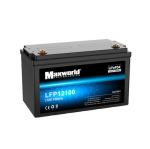
New! Comments
Have your say about what you just read! Leave me a comment in the box below.